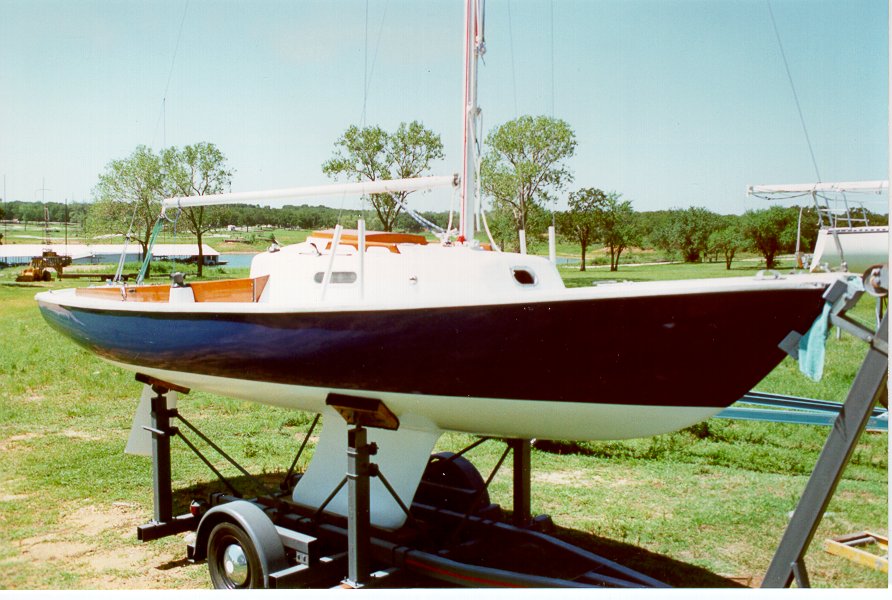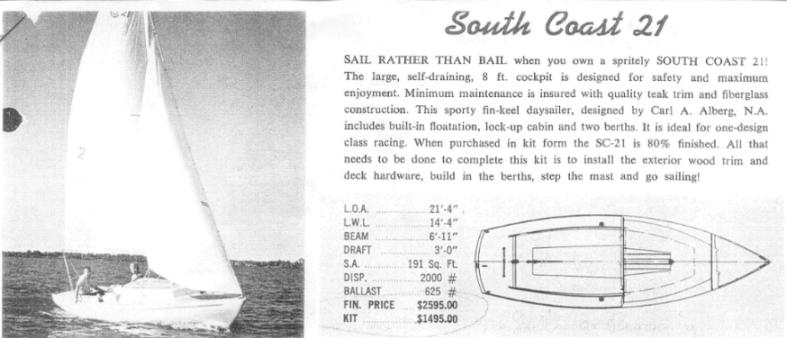|
South Coast 21


The South Coast 21 is a Carl Alberg design. South Coast produced
about 300 of these boats. There is an active racing fleet on Lake Travis
near Austin, Texas.
The early rudder design on these boats was inadequate. In strong winds
boats were known to do 360 degree spins. Later models were equipped with
a redesigned rudder which greatly improved the stability of the boat.
The early rudder has a flair and is wider at the top than the bottom.
The redesigned rudder is straighter and uses a solid post instead of hollow
pipe.
Hollis Metcalf, the owner of the factory, wanted a light
weight daysailer,
approximately 21 feet in length, that would be used primarily on inland
lakes and near-shore coastal areas. The first design submittal by Alberg
was for a full-keeled open cockpit daysailer much like the Ensign. Hollis
sent the design drawings back to Carl Alberg with the direction that the
boat was to have a fin keel and self draining cockpit. Mr. Alberg at first
refused to make the changes, since this was against the traditional thinking
at the time, but finally agreed to the requested modifications.
The fin keel, fractional rig, upper diamond stays, and wide flat stern
sections of the hull of the South Coast 21 were very different from the
typical boats of this era. However many of these aspects are found on
many
of the designs developed more recently.
The boat was available in either fully rigged or kit form. The boat was
shown at various boat shows around the south and was fairly well received
as
an early model fiberglass construction day sailer. The boat was popular
as
a club racer and a set of Class rules were written to encourage the
one-design nature of the boat. These rules have been changed little since
their original format and are still used today.
Two noticeable changes were subsequently made in the design. The first
several boats were found to experience more weather helm than desired
in
higher winds. The boats would sometimes round up when heeled over in a
gust
and would auto-tack if the mainsheet was not released quickly. Thus the
keel was moved a few inches back in boats with hull numbers greater than
90.
This modification did not have the completely desired effect and complaints
of the boat auto-tacking were still received at the factory.
This situation resulted in the factory personnel looking at adding a
larger
rudder to the boat. It was felt that a bigger rudder would allow the boat
to have better control in these situations. The factory personnel
determined that a rudder similar to the one used on the then Olympic Class
boat, the Tempest, would be used. This rudder was unusual in that it was
reversed tapered. That is, the top of the rudder is smaller than the
bottom. This rudder change occurred somewhere around hull number 110.
This
larger rudder also dictated that the rudder shaft be revised from tubular
stainless steel to a solid stainless steel shaft.
This change improved the handling characteristics of the boat in these
conditions. Boat owners also found that replacing the standard traveler
with a low-friction, easily releasable system also made a marked improvement
in the ability of the boats to be manageable in high winds.
Large fleets of these boats developed near the factory in Shreveport
at
Cross Lake and in Austin, Texas at Lake Travis. Subsequently, in the early
seventies, a rivalry developed between the fleets and a Class Championship
Regatta was held annually. The location alternated between these two
fleets.
In the mid nineties, the participation in the Shreveport area diminished
and
the annual alternating regatta was moved to Lake Travis permanently. The
Lake Travis fleet has continued to grow over the years and now numbers
approximately 35 members. The popularity of the boat and the opportunity
to
enjoy competitive one-design racing at a very reasonable cost have allowed
this fleet to become one of the most active fleets at the Austin
Yacht Club.
Club races typically attract over a dozen of the South Coast 21's at Lake
Travis.
_______________________________
Ray L. Shull. P.E.
|